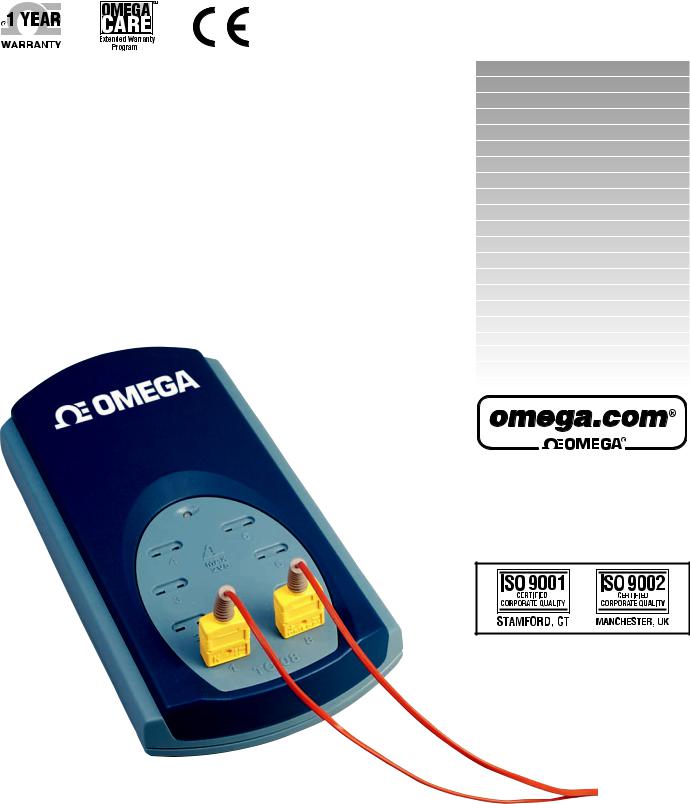Omega TC-08 User Manual 2



 User’sGuide
User’sGuide
Shop online at
omega.com e-mail: info@omega.com For latest product manuals: omegamanual.info
TC-08
8 Channel Thermocouple
USB Data Acquisition Module

|
OMEGAnet® Online Service |
|
Internet e-mail |
|
|
|
omega.com |
|
info@omega.com |
|
|
|
|
|
|
|
Servicing North America: |
||
U.S.A.: |
One Omega Drive, P.O. Box 4047 |
|
||
ISO 9001 Certified |
Stamford, CT 06907-0047 |
|
||
|
|
TEL: (203) 359-1660 |
|
|
|
|
FAX: (203) 359-7700 |
|
|
|
|
e-mail: info@omega.com |
|
|
Canada: |
976 Bergar |
|
||
|
|
Laval (Quebec) H7L 5A1, Canada |
|
|
|
|
TEL: (514) 856-6928 |
|
|
|
|
FAX: (514) 856-6886 |
|
|
|
|
e-mail: info@omega.ca |
|
|
For immediate technical or application assistance:
U.S.A. and Canada:
Mexico:
Sales Service: 1-800-826-6342/1-800-TC-OMEGA®
Customer Service: 1-800-622-2378/1-800-622-BEST®
Engineering Service: 1-800-872-9436/1-800-USA-WHEN®
En Espan˜ol: (001) 203-359-7803 FAX: (001) 203-359-7807 e-mail: espanol@omega.com info@omega.com.mx
Servicing Europe:
Czech Republic: Frystatska 184, 733 01 Karviná, Czech Republic
TEL: +420 (0)59 6311899
FAX: +420 (0)59 6311114 Toll Free: 0800-1-66342 e-mail: info@omegashop.cz
Germany/Austria: Daimlerstrasse 26, D-75392 Deckenpfronn, Germany TEL: +49 (0)7056 9398-0
FAX: +49 (0)7056 9398-29
Toll Free in Germany: 0800 639 7678 e-mail: info@omega.de
United Kingdom: One Omega Drive, River Bend Technology Centre ISO 9002 Certified Northbank, Irlam, Manchester
M44 5BD United Kingdom
TEL: +44 (0)161 777 6611
FAX: +44 (0)161 777 6622
Toll Free in United Kingdom: 0800-488-488 e-mail: sales@omega.co.uk
It is the policy of OMEGA Engineering, Inc. to comply with all worldwide safety and EMC/EMI regulations that apply. OMEGA is constantly pursuing certification of its products to the European New Approach Directives. OMEGA will add the CE mark to every appropriate device upon certification.
The information contained in this document is believed to be correct, but OMEGA accepts
no liability for any errors it contains, and reserves the right to alter specifications without notice. WARNING: These products are not designed for use in, and should not be used for, human applications.

|
|
|
|
Contents |
I |
Contents |
|
|
|
||
|
|
|
|
||
|
|
|
|
||
1 Introduction..................................................................................................................................... |
|
|
|
1 |
|
1 |
Overview........................................................................................................................................... |
|
|
1 |
|
2 |
Installing...........................................................................................................................................the driver |
|
1 |
||
3 |
Connecting...........................................................................................................................................the USB TC-08 |
|
1 |
||
4 |
Safety...........................................................................................................................................warning |
|
|
4 |
|
2 Product information..................................................................................................................................... |
|
|
5 |
||
1 |
Specifications........................................................................................................................................... |
|
|
5 |
|
|
2 How a thermocouple works........................................................................................................................................... |
|
6 |
||
3 Technical reference..................................................................................................................................... |
|
|
7 |
||
1 |
Introduction........................................................................................................................................... |
|
|
7 |
|
2 |
Modes...........................................................................................................................................of operation |
|
7 |
||
|
|
1 |
Introduction........................................................................................................................................... |
|
7 |
|
|
2 Streaming...........................................................................................................................................mode |
|
8 |
|
|
|
3 |
Get Single...........................................................................................................................................mode |
|
10 |
|
|
4 Legacy ...........................................................................................................................................mode |
|
12 |
|
3 |
Driver...........................................................................................................................................routines |
|
|
14 |
|
|
|
1 |
Introduction........................................................................................................................................... |
|
14 |
|
|
2 New USB...........................................................................................................................................mode and legacy mode |
|
15 |
|
|
|
3 New USB...........................................................................................................................................mode only |
|
29 |
|
|
|
4 |
Legacy ...........................................................................................................................................mode only |
|
34 |
|
4 Programming........................................................................................................................................... |
|
|
41 |
|
|
|
1 |
Introduction........................................................................................................................................... |
|
41 |
|
|
2 C and C++........................................................................................................................................... |
|
41 |
|
|
|
3 |
Delphi ........................................................................................................................................... |
|
41 |
|
|
4 |
Excel ........................................................................................................................................... |
|
42 |
|
|
5 LabVIEW........................................................................................................................................... |
|
42 |
|
|
|
6 |
Visual Basic........................................................................................................................................... |
|
42 |
|
|
7 |
Agilent...........................................................................................................................................VEE |
|
42 |
5 |
Troubleshooting........................................................................................................................................... |
|
43 |
||
6 |
Glossary........................................................................................................................................... |
|
|
44 |
|
Index.............................................................................................................................................. |
|
|
|
47 |
|

Introduction 1
1 Introduction
1.1Overview
The USB TC-08 is a temperature and voltage logger designed to support multiple thermocouples. With the accompanying TC-08 software, the unit can be used with any laptop or PC running Windows XP SP2 or Vista. If you are technically-minded and want to tailor the product to a particular application, you can write your own programs with the supplied driver.
The driver provides cold junction compensation for thermocouples. The TC-08 software supports up to 20 USB TC-08 devices and the driver can support more (as many as 64, if you have a high-specification PC).
This manual describes the physical and electrical properties of the USB TC-08, and provides an explanation of how to use the software drivers. For information on the USB TC-08 software, please consult the software help file.
1.2Installing the driver
The driver is installed automatically when you install the TC-08 software. Alternatively, you can download the driver from our website at http://www.omega.com.
1.3Connecting the USB TC-08
Please note: do not connect the USB TC-08 until you have installed the
software and restarted your PC.
To begin using the USB TC-08, connect it to the USB port on your computer using the cable provided. Next, connect a thermocouple to one of the thermocouple input connectors. To complete the installation, select the USB TC-08 unit and thermocouple type in the TC-08 software as follows:
1.Start up the TC-08 Recorder
2.Select New Settings from the File menu.
The Recording dialog box appears:
3. Click the OK button.
The Sampling Rate dialog box appears

2 TC-08 User's Guide
4.Click the OK button.
The Converter details dialog box appears
5.Select USB TC-08 from the drop-down list of converters.
The device name and serial number should appear in the USB Devices pane and the USB enumeration progress bar gradually expand to 100%. If the progress bar does not start moving, disconnect and reconnect the USB TC-08, then click
Refresh.
6.In the USB Devices pane, select the USB TC-08. If you are using more than one USB TC-08, check the serial number on the bottom of the device so that you know which one to select from the list
7.Click the OK button.
The following dialog box appears

Introduction 3
8.In the TC-08 Channels window, double-click on Channel 1 unused.
The Edit TC-08 Channel dialog box appears
9.From the Thermocouple drop-down list, select the type of thermocouple you are using and click OK.
The TC-08 Channels dialog box reappears.
10.Click OK.
Channel 1 should now appear in the monitor window with the current temperature
reading.

4TC-08 User's Guide
1.4Safety warning
We strongly recommend that you read the general safety information below before using your product for the first time. If the equipment is not used in the manner specified, then the protection provided may be impaired. This could result in damage to your computer and/or injury to yourself or others.
Maximum input range
The USB TC-08 is designed to measure voltages in the range of ±70 mV. Any voltages in excess of ±30 V may cause permanent damage to the unit.
Mains voltages
These products are not designed for use with mains voltages.
Safety grounding
The ground of every product is connected directly to the ground of your computer through the interconnecting cable provided. This is done in order to minimise interference. If the PC (especially laptop) is not grounded, reading stability cannot be guaranteed and it may be necessary to manually ground the equipment.
Take care to avoid connecting the inputs of the product to anything which may be at a hazardous voltage. If in doubt, use a meter to check that there is no hazardous AC or DC voltage. Failure to check may cause damage to the product and/or computer and could cause injury to yourself or others.
Take great care when measuring temperatures near mains equipment. If a sensor is accidentally connected to mains voltages, you risk damage to the converter or your computer and your computer chassis may become live.
You should assume that the product does not have a protective safety earth. Incorrect configuration or use of the device to measure voltages outside the maximum input range can be hazardous.
Repairs
The unit contains no user-serviceable parts: repair or calibration of the unit requires specialised test equipment and must be performed by Omega Engineering.

Product information |
5 |
|
|
2 |
Product information |
|
2.1 |
Specifications |
|
|
|
|
|
Resolution |
20 bits (16.25 NFR) |
|
|
|
|
Thermocouple types |
B,E,J,K,N,R,S,T |
|
|
|
|
Number of input channels |
8 |
|
|
|
|
Conversion time - per active channel |
100 ms |
|
|
|
|
Conversion time - CJC |
100 ms |
|
|
|
|
Uncalibrated accuracy |
The sum of ±0.2% and ±0.5°C |
|
|
|
|
Full scale input |
±70 mV |
|
|
|
|
Common mode range |
±7.5 V |
|
|
|
|
Overvoltage protection |
±30 V |
|
|
|
|
Input impedance |
2 MΩ |
|
|
|
|
Input connectors |
8 x miniature thermocouple |
|
|
|
|
Output connector |
USB upstream connector |
|
|
|
|
Power requirements |
No power supply required |
|
|
|
|
Environmental conditions |
0 to 50°C, 25% to 75% humidity |
|
|
Quoted accuracy over 20 - 30°C |
|
|
NOT water-resistant |
|
|
|
Note: The resolution and accuracy depend upon the thermocouple type and the temperature range. Below is a list of the thermocouples and temperature ranges supported by the USB TC-08.
|
Actual measurable range |
Theoretical ranges |
|
|
|
CJC |
-5°C to 70°C |
N/A |
Type B |
20°C to 1820°C (CJC must be |
0°C to 1820°C |
|
>20°C) |
|
Type E |
-270°C to 910°C |
-270°C to 1000°C |
Type J |
-210°C to 1200°C |
-210°C to 1200°C |
Type K |
-270°C to 1370°C |
-270°C to 1370°C |
Type N |
-270°C to 1300°C |
-270°C to 1300°C |
Type R |
-50°C to 1760°C |
-50°C to 1760°C |
Type S |
-50°C to 1760°C |
-50°C to 1760°C |
Type T |
-270°C to 400°C |
-270°C to 400°C |
|
|
|

6TC-08 User's Guide
2.2How a thermocouple works
In a closed circuit of two dissimilar metals (a thermocouple), an electric current flows when one of the two junctions is heated with respect to the other. The current continues to flow as long as the two junctions are at different temperatures. The magnitude and direction of the current is a function of the temperature difference between the junctions and of the thermal properties of the metals used in the circuit. This phenomenon is known as the Seebeck Effect.
The conductors can be made of any two dissimilar metals, and when the hot junction is heated the current flow can be observed. If the positions of the hot and cold junctions are reversed, current flows in the opposite direction.
A thermocouple circuit actually generates a measurable, low-voltage output that is almost directly proportional to the temperature difference between the hot junction and the cold junction. A change in this temperature difference produces some net change in the voltage.
Note: More information on choosing and using thermocouples can be found at www.omega.com.

Technical reference |
7 |
|
|
3 |
Technical reference |
3.1Introduction
The USB TC-08 is supplied with driver routines that you can build into your own programs. The USB TC-08 driver supports Windows XP SP2 and Windows Vista.
Once you have installed the software, the Examples directory will contain the drivers and a selection of examples of how to use the drivers.
The driver is supplied as a Windows DLL. The DLL uses the C stdcall calling convention and can be used with C, Delphi and Visual Basic programs. It can also be used with programs like Microsoft Excel, where the macro language is a form of Visual Basic.
3.2Modes of operation
3.2.1Introduction
The USB TC-08 is designed for three specific modes of operation to suit a variety of applications. The following modes are supported:
Streaming mode
Get Single mode
Legacy mode

8TC-08 User's Guide
3.2.2Streaming mode
Streaming mode is an operational mode in which the USB TC-08 unit samples data and returns it to the computer in an unbroken sequence, using the onboard clock to ensure accurate timing.
The unit can buffer up to two sets of readings at once. To avoid loss of readings, make sure that another application on the PC - including the one you are writing - does not prevent the driver from collecting readings for more than three sampling intervals.
To allow the driver to sample continuously, call the Windows Sleep() function in any sampling loops (see example below) to make sure that your application does not use too much processor time.
Hint: Try not to use a Sleep() call for less than 50-100 milliseconds, e.g.,
Sleep(50) or Sleep(100). If you are programming a Windows GUI application, a good alternative to sampling loops is the WM_TIMER message.

Technical reference |
9 |
|
|
Example
The following code is a fragment of a C application demonstrating how to use
Streaming mode with the USB TC-08 driver:
//==================================================
// Setting up and running the unit in Streaming mode
//==================================================
usb_tc08_set_mains(handle, 0); // use 50Hz mains noise rejection
for (channel = 0; channel < 9; channel++)
{
//set each channel up as a type K thermocouple
//channel 0 is the cold junction and will be enabled
//by setting the third argument to anything other than ' ' usb_tc08_set_channel(handle, channel, 'K');
}
//find out how fast the unit can sample in its current setup state minimum_interval = usb_tc08_get_minimum_interval_ms(handle);
usb_tc08_run(handle, minimum_interval); // sample as fast as possible
//not required (just illustrates that the application
//can be idle while the driver collects the readings) Sleep(10000);
//use a two dimensional array with an array of readings for each channel
//In a real application, this would be a nested loop to regularly poll
//the unit for readings
for (channel = 0; channel < 9; channel++)
{
no_of_readings = usb_tc08_get_temp( handle, &reading_buffer[channel], ×_buffer[channel], buffer_length, &overflows[channel], channel,
0, // degrees Celsius units
0); // do not fill missing readings
}
//finished polling, now do something with the readings
//if overflows[channel] is high, then one of the readings
//in reading_buffer[channel] has exceeded the input range
//of the USB TC-08
//only stop the unit when we've completely finished streaming usb_tc08_stop(handle);
Note: You should close down all other applications while you are performing any timing-critical data logging tasks. Check that the Windows scheduler does not have any activities planned during the logging session.

10TC-08 User's Guide
3.2.3Get Single mode
Get Single mode is an operational mode in which readings are produced on demand, using the usb_tc08_get_single function. Since the function relies entirely on the timing of the calling application, it is ideal for time intervals greater than 1 minute. If high-speed sampling is required, use Streaming mode.
Note: The function call overhead can be significant, since it takes approximately 360 ms to convert all 9 channels, equating to 40 ms per channel. To reduce this overhead, disable channels that are not required.

Technical reference |
11 |
|
|
Example
The following code is a fragment of a C application demonstrating how to use Get
Single mode with the USB TC-08 driver:
//========================================================
// Setting up and converting readings with Get Single mode
//========================================================
usb_tc08_set_mains (handle, 0); // use 50Hz mains noise rejection
for (channel = 0; channel < 9; channel++)
{
//set each channel up as a type K thermocouple
//channel 0 is the cold junction and will be enabled
//by setting the third argument to anything other than ' ' usb_tc08_set_channel (handle, channel, 'K');
}
//find out the approximate conversion time
//for a call to usb_tc08_get_single
minimum_interval = usb_tc08_get_minimum_interval_ms (handle); printf("Conversion time: %d\n", minimum_interval);
// Collect 10 readings over approximately 9 minutes last_time = GetTickCount();
for (i = 0, i < 10, i++)
{
// do the conversion for all channels usb_tc08_get_single( handle,
value_array, // short value_array[9] &overflow_flags,
0); |
// degrees Celsius units |
// print out the values printf("\n\nTime: %d minute(s)", i); for (c = 0; c < 9; c++)
{
//check for overflows on each channel
//with a bitwise & comparator
//shift the comparison bit to match the channel if (overflow_flags & (1 << c))
{
printf("\nChannel %d overflowed", c);
}
else // no overflow
{
printf("\nChannel %d: %f", c, value_array[c]);
}
}
if (i < 9)
{
while (60000 > (GetTickCount() - last_time)) // 60000ms = 1 minute
{
Sleep(100); // let other applications run
}
last_time = GetTickCount();
}
}

12TC-08 User's Guide
3.2.4Legacy mode
Legacy mode is designed to aid developers who have already written code for the serial version of the TC-08 and are not yet ready to rewrite their code for the Streaming or Get Single modes available with the USB version. The legacy support is going to be phased out and will eventually be removed from the driver altogether. If you want full support in the future, use the Streaming or Get Single modes.
To allow code to be easily developed for both the serial version and the USB version of the TC-08, all the function names have been changed. The usb_tc08_legacy_set_channel function no longer supports offset and gain - this is now stored only as calibration information in the unit itself. The legacy routines will be familiar if you previously used the serial TC-08, but the following changes should be made to convert legacy applications:
Reference the new Header file
Reference the new Library file
Place the new DLL in the directory of the application
Set the mains frequency
Run and stop the unit
Store a handle returned from usb_tc08_open_unit instead of using the serial port number

Technical reference |
13 |
|
|
Example
The following code is a fragment of a C application demonstrating how to use legacy
mode with the USB TC-08 driver:
//==========================================================
//Setting up and running the unit in Legacy mode
//This is designed to make it easier to adapt code written
//for the Serial TC08 for use with the USB TC08 //==========================================================
usb_tc08_set_mains(handle, 0); // use 50Hz mains noise rejection
for (channel = 1; channel < 9; channel++)
{
//set each channel up as a type K thermocouple
//switch off filtering for all channels
usb_tc08_legacy_set_channel(handle, channel, 'K', 0);
}
usb_tc08_legacy_run(handle);
last_cycle_no = 0; no_of_readings = 0;
while (no_of_readings < 50) // collect 50 readings
{
usb_tc08_legacy_get_cycle(handle, &this_cycle_no);
if (last_cycle_no != this_cycle_no)
{
last_cycle_no = this_cycle_no; no_of_readings++;
for (channel = 1; channel < 9; channel++)
{
usb_tc08_legacy_get_temp( &reading[channel], handle,
channel,
0);
}
//now do something with the readings
//check that they have not overflowed
//by comparing each reading with 2147483647L
//or LONG_MAX (include limits.h)
usb_tc08_legacy_get_cold_junction(handle, &cold_junction); // now do something with the cold junction temperature
}
}
usb_tc08_stop(handle);
